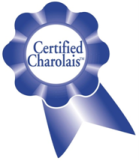Past Presidents1968-1975 J M Sutherland
1975-1978 J E Austin
1978-1981 I S Thomas
1981-1984 J Gunn
1984-1987 D G Lomas
1987-1990 B T Fisher
1990-1993 R Tilsley
1993-1996 W B Wright
1996-1997 B B Bryant
1998-2004 G M Hassall
2005-2010 B W McKenzie 2010-2014 W A Semenoff 2014-2018 A (Drew) Dundass Current PresidentMr Stuart BryantPast Secretary/ManagersMr D E Reid, Interim Accountant/Secretary
1968-1980 Mr T W Tothill
1980- 2009 Mrs P A Mellon
Current Secretary/ManagerMrs E M Harvey (Liz) |
HistoryFrom French Origins To Kiwi Developments ... The Charolais Continues To Improve.
The Charolais breed was developed and established in the Charolles district in central France, the ancestors of today’s Charolais were not only suited to draught but by the early seventeenth century they were also producing highly rated meat for the markets in Lyon and Villefranche. Improvement through selective breeding commenced early in the nineteenth century, and the French Charolais Herd Book was established in 1864.
New Zealand Bound
The first Charolais semen was imported to New Zealand from Britain in 1965 for trials at Lincoln and Ruakura. The following year commercial semen was brought in by Mr J M Sutherland of “Centrewood”, Waimate. He had seen Charolais while on holiday in France and was so impressed at their size that he determined to introduce them to the New Zealand beef scene.
Between 1969 and 1981; 61 bulls and 302 females were imported into New Zealand from Great Britain, forming the basis of the Full French Charolais in the country. The majority of purebred cattle have been bred by "grading up" using a French Charolais sire over a base Angus, Friesian or Hereford cow. By the fifth generation (31/32) purebred status is reached. In this way a "New Zealand" Charolais has been developed, still with the Charolais growth rate and muscle, but better suited to the beef production systems used in New Zealand.
The Formation of the New Zealand Charolais Cattle Society
More than forty years ago, Wednesday 4 September 1968 in the RSA Clubrooms, Oamaru, the New Zealand Charolais Cattle Society (NZCCS) was born. Thirty-four people attended together with representatives from the Christchurch Press and Otago Daily Times.
Mr J M Sutherland of Waimate was appointed Acting President. A sub-committee of J O Acland, J E Austin and P H Elworthy was given the task of setting out the Objects and Rules of the new Society. Its stated aim: To encourage, promote and improve the breeding of Charolais cattle in New Zealand and to establish relationships with other breed societies. The Society expanded rapidly and by 1973 had a membership of 319. The NZCCS proudly celebrates this auspicious Anniversary. Since that day in 1968 the breed Charolais has taken its place as the foremost terminal beef sire breed in the country. The Early Years
In 1962 when the Director-General of Agriculture, D N R Webb, was in Europe, he pursued his interest in the Charolais breed with a visit to Nevers. There he was escorted to several Charolais Fairs and studs by the President of the Charolais Herd Book Mr Emille Maurice, and his son, Francois, later Executive President of FIAERBC.
On his return to London he approached the British authorities for an allocation of semen so that trial work could be started at Ruakura.
However it was not possible to negotiate a way around the prohibition on exports then in force. The best that could be achieved was a promise that supplies would be made available when the prohibition was lifted.
This happened in 1965, and fortunately for the future of the breed in New Zealand, it coincided with a visit to Europe of Mr Jack Sutherland. His hotel in Navarre in France was crowded with enthusiasts from many countries attending the Charolais sales. He accepted an invitation to accompany the delegates from the United Kingdom. He was so impressed by what he saw and by what he learnt from the experience of Angus, Friesian and Shorthorn cows as matrons. His efforts to win official approval, however, were not immediately successful, as evidenced by the following extract of a letter dated 2 August, 1965, from the Department of Agriculture: “This question of the establishment of Charolais in New Zealand has, as you know, been a very contentious issue, and has been opposed by some breeders.
Embodied in the opposition has been many comments about the dangers of introducing exotic diseases, such as foot and mouth. In consequence, the Government has decided to proceed cautiously and the permits for the initial batch of semen will be confined to those required for experimental work to be centred round Ruakura and possibly the two Agricultural Colleges”
Jack Sutherland refused to surrender his ambitions. He was determined to improve beef performance in New Zealand. He supplied his cows to Ruakura for evaluation to be carried out on them and with the help of the Hon Duncan McIntyre, Minister of Land, succeeded in obtaining an allocation from the original Government importation of semen for later insemination. Thus the Charolais breed was launched commercially in New Zealand, the first new breed introduced into New Zealand since the importation of the Galloways in 1947. Mr Sutherland had never had anything like the growth rate achieved by these calves in his cattle before. There were to be other “firsts” for Jack Sutherland:
Over the years Charolais spread throughout New Zealand, with Charolais crossbred calves consistently selling at $20-$50 more at calf sales. This was vindication of the faith Jack Sutherland had in the breed from the beginning.
NZ Representation On The International Stage
|

